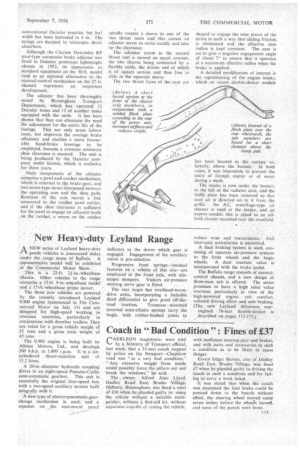New Heavy-duty Leyland Range
Page 51

If you've noticed an error in this article please click here to report it so we can fix it.
rtA NEW 'series of Leyland heavy-duty goods vehicles is announced today under the range name of Buffalo. A representative model will be exhibited at the Commercial Motor Show.
This is a 22-ft. 24-in.-wheelbase chassis. Other vehicles in the range comprise a 17-ft. 9-in.-wheelbase model and 15-ft.-wheelbase prime mover.
The three new vehicles are powered by the recently introduced Leyland 0.900 engine (announced in The Commercial Motor on July 13) and are designed for high-speed working in overseas countries, particularly in conjunction with drawbar trailers. They are rated for a gross vehicle weight of 25 tons and a gross train weight of 45 tons.
The 0.900 engine is being built by Albion Motors, Ltd., and develops 200 b.h.p. at 1,800 r.p.m. it is a 'sixcylindered direct-injection unit of 15.2 litres.
A 20-in.-diameter hydraulic coupling drives to an eight-speed Pneumo-Cyclic semi-automatic gearbox. This unit is essentially the original four-speed box with a two-speed auxiliary section built integrally with it.
A new type of electro-pneumatic gearchange mechanism is used, and a repeater on the instrument panel
indicates to the driver which gear is engaged. Engagement of the auxiliary ratios is pre-selective.
Progressive front springs—unusual features on a vehicle of this size—are employed at the front axle, with telescopic dampers. Vickers air-pressure steering servo gear is fitted.
The rear bogie has overhead-wormdrive axles, incorporating a lockable third .differential to give good off-the road traction. Trunnion mounted inverted semi-elliptic springs carry the bogie, with rubber-bushed joints to reduce wear and maintenance. Full inter-axle articulation is permitted.
A dual braking -system is used, consisting of separate air-pressure systems to the front wheels and the bogie wheels. A dual reaction valve is incorporated with the brake pedal.
The Buffalo range consists of normalcontrol chassis, and a new design of three-man cab is offered. The seriespromises to have a . high sales value overseas, particularly in view of the high-powered engine, cab comfort, reduced driving effort and safe braking. [The new Leyland Atlantean rear engined 78-seat double-decker is described on pages 172-175.]








































































































